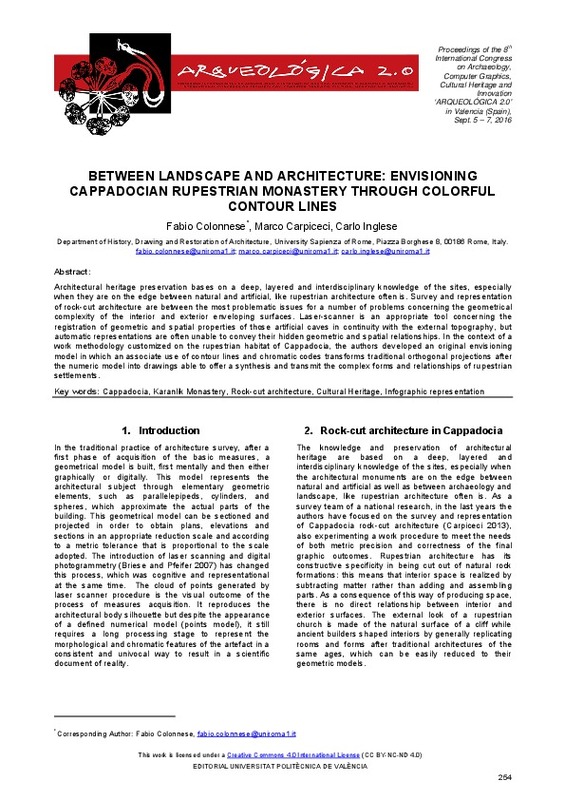JavaScript is disabled for your browser. Some features of this site may not work without it.
Buscar en RiuNet
Listar
Mi cuenta
Estadísticas
Ayuda RiuNet
Admin. UPV
BETWEEN LANDSCAPE AND ARCHITECTURE: ENVISIONING CAPPADOCIAN RUPESTRIAN MONASTERY THROUGH COLORFUL CONTOUR LINES
Mostrar el registro sencillo del ítem
Ficheros en el ítem
| dc.contributor.author | Colonnese, Fabio
|
es_ES |
| dc.contributor.author | Carpiceci, Marco
|
es_ES |
| dc.contributor.author | Inglese, Carlo
|
es_ES |
| dc.coverage.spatial | east=34.83133399999997; north=38.644849; name= Capadocia, Turquia | |
| dc.date.accessioned | 2017-07-11T07:08:31Z | |
| dc.date.available | 2017-07-11T07:08:31Z | |
| dc.date.issued | 2016-10-27 | |
| dc.identifier.isbn | 9788490484555 | |
| dc.identifier.uri | http://hdl.handle.net/10251/84891 | |
| dc.description.abstract | [EN] Architectural heritage preservation bases on a deep, layered and interdisciplinary knowledge of the sites, especiallywhen they are on the edge between natural and artificial, like rupestrian architecture often is. Survey and representation of rock-cut architecture are between the most problematic issues for a number of problems concerning the geometrical complexity of the interior and exterior enveloping surfaces. Laser-scanner is an appropriate tool concerning the registration of geometric and spatial properties of those artificial caves in continuity with the external topography, but automatic representations are often unable to convey their hidden geometric and spatial relationships. In the context of a work methodology customized on the rupestrian habitat of Cappadocia, the authors developed an original envisioning model in which an associate use of contour lines and chromatic codes transforms traditional orthogonal projections after the numeric model into drawings able to offer a synthesis and transmit the complex forms and relationships of rupestrian settlements. | es_ES |
| dc.format.extent | 3 | es_ES |
| dc.language | Inglés | es_ES |
| dc.publisher | Editorial Universitat Politècnica de València | es_ES |
| dc.relation.ispartof | 8th International congress on archaeology, computer graphics, cultural heritage and innovation | es_ES |
| dc.rights | Reconocimiento - No comercial - Sin obra derivada (by-nc-nd) | es_ES |
| dc.subject | Data acquisition | es_ES |
| dc.subject | Photogrammetry | es_ES |
| dc.subject | Remote sensing | es_ES |
| dc.subject | Documentation | es_ES |
| dc.subject | Cultural heritage | es_ES |
| dc.subject | Digitisation | es_ES |
| dc.subject | 3D modelling | es_ES |
| dc.subject | Virtual archaeology | es_ES |
| dc.subject | Virtual museums | es_ES |
| dc.subject | Virtual exhibitions | es_ES |
| dc.subject | Collaborative environments | es_ES |
| dc.subject | Internet technology | es_ES |
| dc.subject | Social media | es_ES |
| dc.subject | Architecture | es_ES |
| dc.title | BETWEEN LANDSCAPE AND ARCHITECTURE: ENVISIONING CAPPADOCIAN RUPESTRIAN MONASTERY THROUGH COLORFUL CONTOUR LINES | es_ES |
| dc.type | Capítulo de libro | es_ES |
| dc.type | Comunicación en congreso | es_ES |
| dc.identifier.doi | 10.4995/arqueologica8.2015.2906 | |
| dc.rights.accessRights | Abierto | es_ES |
| dc.description.bibliographicCitation | Colonnese, F.; Carpiceci, M.; Inglese, C. (2016). BETWEEN LANDSCAPE AND ARCHITECTURE: ENVISIONING CAPPADOCIAN RUPESTRIAN MONASTERY THROUGH COLORFUL CONTOUR LINES. En 8th International congress on archaeology, computer graphics, cultural heritage and innovation. Editorial Universitat Politècnica de València. 254-256. https://doi.org/10.4995/arqueologica8.2015.2906 | es_ES |
| dc.description.accrualMethod | OCS | es_ES |
| dc.relation.conferencename | ARQUEOLÓGICA 2.0 - 8th International Congress on Archaeology, Computer Graphics, Cultural Heritage and Innovation | es_ES |
| dc.relation.conferencedate | September 05-07,2016 | es_ES |
| dc.relation.conferenceplace | Valencia, Spain | es_ES |
| dc.relation.publisherversion | http://ocs.editorial.upv.es/index.php/arqueologica20/arqueologica8/paper/view/2906 | es_ES |
| dc.description.upvformatpinicio | 254 | es_ES |
| dc.description.upvformatpfin | 256 | es_ES |
| dc.type.version | info:eu-repo/semantics/publishedVersion | es_ES |
| dc.relation.pasarela | OCS\2906 | es_ES |








